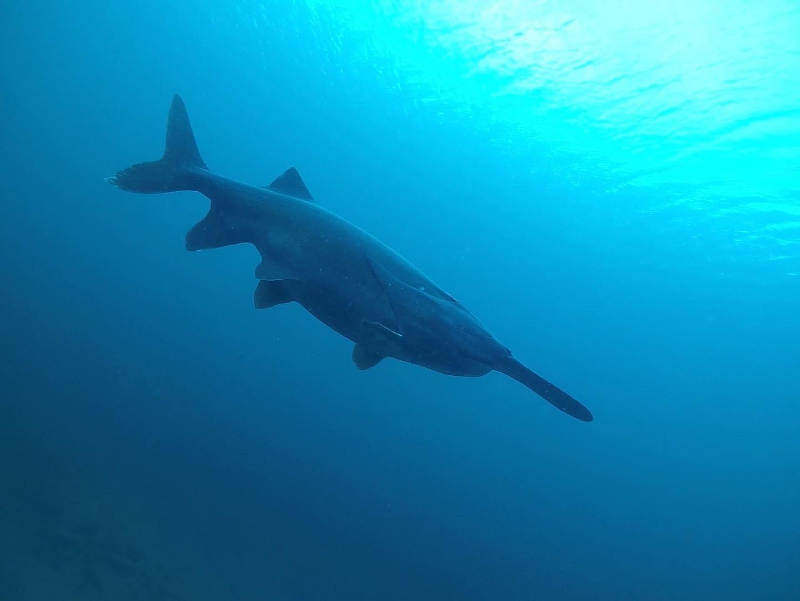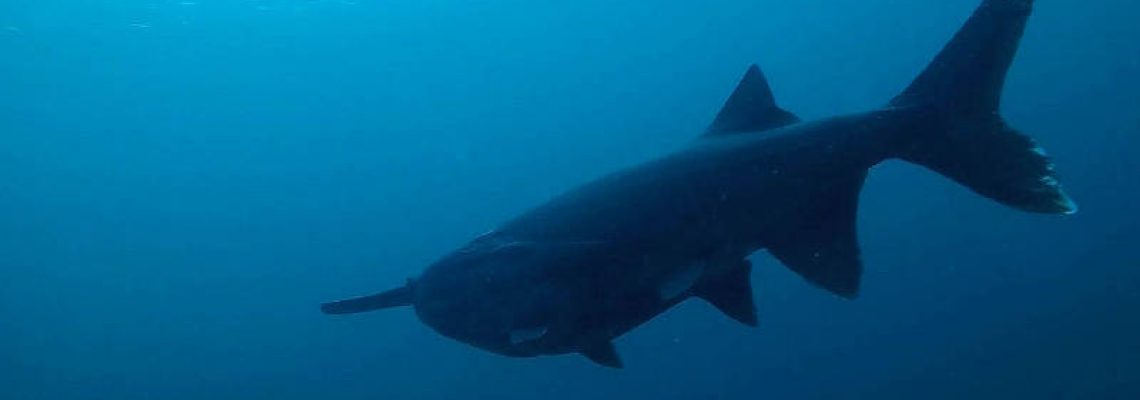American Paddlefish (Polyodon spathula) is one of North America’s largest freshwater fish and can grow to an average length of about 5 feet, with some reports of specimens in excess of 7 feet. Generally considered a “living fossil”, Paddlefish are among the oldest freshwater fish, with fossil records dating back around 150 million years.
Sighting the Paddlefish is always a treat, no matter how many times you visit France Park. Everyone enjoys riding the Hippo and visiting the airplane, but nothing makes a diver more excited than spotting their first Paddlefish.
Polyodon Spathula
They are most closely related to the other fishes of the order (Acipenseriformes), though they are classified in a separate clade (group) all together from the sturgeon family and the exact relationships between these two groups of fish are still being researched by scientists. They are the only extant (living) member of their family Polyodontidae and are easily distinguished by a long rostrum that is shaped like a “Paddle” or spatula, which is where they get the namesake (Polyodon spathula). The “paddle” itself is lined with unique sensory organs which allow the fish to detect clouds of zooplankton in a similar way to the way a metal detector can detect magnetic fields. When they find an area with plenty of food, they open their large mouths, much like a basking shark, and filter the zooplankton through multiple rows of unique “gill rakers”, which can be seen directly from the front when they are feeding, or what some scuba divers call “at full sail”. Interestingly, they have an almost entirely cartilage skeleton, much like marine Chondrythians (sharks and rays) as well.

Due to the smooth nature of their skin, Paddlefish are sometimes referred to as “Spoonbill Catfish”, however this is a misnomer as they are not related to the catfish family whatsoever. They’re closely related to the other fishes of the order (Acipenseriformes), though they are classified in a separate group all together from the sturgeon family and the exact relationships between these two groups of fish are still being researched by scientists. Scuba divers have often referred to them as “quarry sharks” due to their smooth appearance and deeply forked caudal fin (tail), which resembles that of some marine species of shark.
Paddlefish Hunting
Paddlefish have historically done well in the Mississippi river basin and are known to migrate over vast distances in deep rivers and lakes for spawning. However this makes them particularly at home in very low visibility water (why they have relatively small eyes) and therefore, historically difficult to video and study. In addition, exceptionally large specimens are under-represented in many populations due to alteration of spawning routes and overfishing in lakes and reservoirs. To date, some of the very best and clearest footage of American Paddlefish, especially large specimens has been captured by scuba divers in large lakes and quarries. Though quarries do not make ideal habitat for spawning, Paddlefish often do well in them and have been known to live quite long when introduced due to several factors including increased water quality and strict regulations on fishing in most places where scuba diving is permitted. Easily the best time of year to spot and video Paddlefish, particularly in quarries, is during cool water months. Divers who are respectful and do not attempt to touch them are often gifted with an unusually close encounter in crystal clear water, often resulting in fantastic footage of these large, prehistoric creatures. The Indy Dive Center loves their Paddlefish!
The Law
Due to overharvesting as well as poaching of Paddlefish, many states have implemented strict regulations on fishing. For example, it is illegal in Indiana to take any Paddlefish from any water in the state under a sport fishing license, as the population is not stocked by the state. One of the first and foremost ways of protecting Paddlefish is respecting all federal and state regulations regarding fishing and wildlife management. Always be a good steward of your environment. Know your local laws and regulations and leave wild areas cleaner than you found them. Another way to help Paddlefish is to simply purchase a fishing license. Even if you never go fishing, funds from the sales of hunting and fishing licenses often make up the majority of funds used in fisheries support as well as research. Moreover, these sales often net more funds for the management of wild populations through federal grand matching programs as well. Often, the best support for wildlife is simple exposure. Research and visit dive sites who have Paddlefish. If you are lucky enough to have an encounter with these beautiful fish, be sure to share that experience and make sure your friends and dive buddies appreciate the beauty and rarity of the one of a kind, prehistoric Paddlefish.

